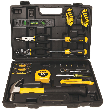Installing a Brick Pathway
Written by Lee Wyatt (last updated August 27, 2014)
Have you ever noticed how many new homes do not come with brick pathways already installed? The reason for this is that it is an optional feature that home builders often do not want to take the time to do. However, installing a brick pathway is a project that you can do yourself if you only take the time and are careful. The guidelines listed below will tell you how you can go about installing a brick pathway yourself. There is one catch though, and that is this article cannot tell you how much materials you will need. The reason for this is rather simple in that no two paths will ever be the same.
- Plan ahead. Before you even begin laying down the first brick, or marking out where the path is going to be, you need to plan ahead. This means that if you can actually draw out a "blueprint" that you can use. Where are you going to place the path? The logical location would be to put one where it will do the most good, which means placing it where people travel the most. While you are creating the blue print, keep in mind that it should have plenty of room to move things around (such as lawn chairs, basketball hoops, etc.).
- Draw out the path. Using some spray paint, actually draw out the path on the ground. This will allow you to have a better idea for the amount of work that you will be doing, as well as allowing you to get fairly accurate measurements. After you have drawn out the path, measure everything (at least twice) and write the results down on the blueprint that you created earlier. This way you can take the blueprint into the home improvement store and purchase all the materials that you will need.
- Dig in. Once you have drawn out the location for the path and purchased all the materials that you will need, it is time to start digging in. Starting at the outside of the path, and working your way in, begin digging down to a depth of between nine and ten inches. Make the bottom of the trench as flat as possible.
- Lay the base. Using some paver gravel, begin laying your base. This base should be about four to six inches thick. The gravel will allow water to seep through in a controlled manner and help prevent erosion. Make sure that the gravel is as level as possible before you move onto the next step.
- Install the fabric and edging. Over the top of the gravel, you need to lay some landscaping fabric, as well as edging. The fabric should be tight, but not tight enough to allow any tearing to develop. The edging should be placed about six inches away from the outermost edge of the path, and over the top of the landscaping fabric. Begin back filling the edging with the loose dirt and from when you dug out the trench. This will all help hold the fabric in place.
- Pour some sand. Pour a layer of sand about one inch thick over the top of the landscaping material. This will help hold the bricks in place and allow for some settling and adjustment over time. It will also help prevent the bricks from accidentally breaking as you place them.
- Settle the bricks. Begin laying your bricks down in whatever pattern you decide would look best. Once you have an individual brick in place, knock it once or twice with a robber mallet to help settle it firmly. Be careful that you do not knock the bricks hard enough to actually break them. Use a masonry saw and hammer to form any bricks into curves if your design calls for that. Repeat the process until you have completed the path.
- Pour and sweep sand. Over the recently settled bricks, pour another inch of sand. Using a large deck broom spread the sand over the bricks. This will help get some sand down in the cracks between the bricks, and help hold the bricks in place. Pick up and dispose of any loose sand, and then sit back and enjoy your new brick pathway.
Author Bio
Lee Wyatt
Contributor of numerous Tips.Net articles, Lee Wyatt is quickly becoming a regular "Jack of all trades." He is currently an independent contractor specializing in writing and editing. Contact him today for all of your writing and editing needs! Click here to contact. Learn more about Lee...
Watering Seeds Properly
Have you ever stopped to think about just how difficult watering seeds can be? While all seeds may need water to properly ...
Discover More
Planting Grass Seed
One of the most important aspects of preparing your lawn and landscape is actually planting grass seed. If you would like ...
Discover More
Finding Good Rain Gutters
For some reason people don't really think about their gutters until it is too late. That time period is usually during ...
Discover More
More Home Improvement Tips
Decorate Your Deck
Decks can be a wonderful addition to any landscaping scheme, as long as they are decorated properly. Basically, ...
Discover More
Installing Gutter Guards
Gutter guards can be a very effective and helpful tool that will not only save your gutters from damage, but also help ...
Discover More
Pouring a New Sidewalk
Over time, even the best laid sidewalks become a little damaged and need some repair. Unfortunately, there are going to ...
Discover More

Comments